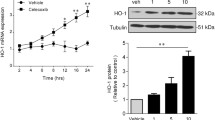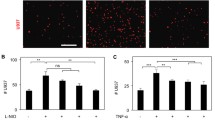Abstract
Purpose
Polymorphonuclear neutrophils, the first leukocytes to infiltrate the inflamed tissue, can make important contributions to vascular inflammatory processes driving the development of atherosclerosis. We herein investigated the effects of atorvastatin and NCX 6560 (a nitric oxide (NO)-donating atorvastatin derivative that has completed a successful phase 1b study) on neutrophilic inflammation in carotid arteries of normocholesterolemic rabbits subjected to perivascular collar placement.
Methods
Atorvastatin or NCX 6560 were administered orally (5 mg/kg/day or equimolar dose) to New Zealand White rabbits for 6 days, followed by collar implantation 1 h after the last dose. Twenty-four hours later carotids were harvested for neutrophil quantification by immunostaining.
Results
Treatment with NCX 6560 was associated with a lower neutrophil infiltration (−39.5 %), while atorvastatin did not affect neutrophil content. The result was independent of effects on plasma cholesterol or differences in atorvastatin bioavailability, which suggests an important role of NO-related mechanisms in mediating this effect. Consistent with these in vivo findings, in vitro studies showed that NCX 6560, as compared to atorvastatin, had greater inhibitory activity on processes involved in neutrophil recruitment, such as migration in response to IL-8 and IL-8 release by endothelial cells and by neutrophils themselves. Pretreatment with NCX 6560, but not with atorvastatin, reduced the ability of neutrophil supernatants to promote monocyte chemotaxis, a well-known pro-inflammatory activity of neutrophils.
Conclusion
Experimental data suggest a potential role of NO-releasing statins in the control of the vascular inflammatory process mediated by polymorphonuclear neutrophils.






Similar content being viewed by others
References
World Health Organization (WHO). Cardiovascular diseases (CVDs). Fact sheet N.°317, September 2011. http://www.who.int/mediacentre/factsheets/fs317/en/index.html
Allender S, Scarborough P, Peto V, et al. European cardiovascular disease statistics 2008 ed. EH Network; 2008
Baigent C, Blackwell L, Emberson J, et al. Efficacy and safety of more intensive lowering of LDL cholesterol: a meta-analysis of data from 170,000 participants in 26 randomised trials. Lancet. 2010;376:1670–81.
Weber C, Noels H. Atherosclerosis: current pathogenesis and therapeutic options. Nat Med. 2011;17:1410–22.
Tedgui A. Focus on inflammation. Arterioscler Thromb Vasc Biol. 2011;31:958–9.
Charo IF, Taub R. Anti-inflammatory therapeutics for the treatment of atherosclerosis. Nat Rev Drug Discov. 2011;10:365–76.
Zernecke A, Bot I, Djalali-Talab Y, et al. Protective role of CXC receptor 4/CXC ligand 12 unveils the importance of neutrophils in atherosclerosis. Circ Res. 2008;102:209–17.
Drechsler M, Megens RT, van Zandvoort M, Weber C, Soehnlein O. Hyperlipidemia-triggered neutrophilia promotes early atherosclerosis. Circulation. 2010;122:1837–45.
Baetta R, Corsini A. Role of polymorphonuclear neutrophils in atherosclerosis: Current state and future perspectives. Atherosclerosis. 2010;210:1–13.
Murphy AJ, Woollard KJ, Suhartoyo A, et al. Neutrophil activation is attenuated by high-density lipoprotein and apolipoprotein A-I in in vitro and in vivo models of inflammation. Arterioscler Thromb Vasc Biol. 2011;31:1333–41.
Nicholls SJ, Dusting GJ, Cutri B, et al. Reconstituted high-density lipoproteins inhibit the acute pro-oxidant and proinflammatory vascular changes induced by a periarterial collar in normocholesterolemic rabbits. Circulation. 2005;111:1543–50.
Puranik R, Bao S, Nobecourt E, et al. Low dose apolipoprotein A-I rescues carotid arteries from inflammation in vivo. Atherosclerosis. 2008;196:240–7.
Wu BJ, Yan L, Charlton F, et al. Evidence that niacin inhibits acute vascular inflammation and improves endothelial dysfunction independent of changes in plasma lipids. Arterioscler Thromb Vasc Biol. 2010;30:968–75.
Murad F. Shattuck Lecture. Nitric oxide and cyclic GMP in cell signaling and drug development. N Engl J Med. 2006;355:2003–11.
Pepine CJ. The impact of nitric oxide in cardiovascular medicine: untapped potential utility. Am J Med. 2009;122:S10–5.
Maskrey BH, Megson IL, Whitfield PD, Rossi AG. Mechanisms of resolution of inflammation: a focus on cardiovascular disease. Arterioscler Thromb Vasc Biol. 2011;31:1001–6.
Bolla M, Almirante N, Benedini F. Therapeutic potential of nitrate esters of commonly used drugs. Curr Top Med Chem. 2005;5:707–20.
Ongini E, Impagnatiello F, Bonazzi A, et al. Nitric oxide (NO)-releasing statin derivatives, a class of drugs showing enhanced antiproliferative and antiinflammatory properties. Proc Natl Acad Sci U S A. 2004;101:8497–502.
Rossiello MR, Momi S, Caracchini R, et al. A novel nitric oxide-releasing statin derivative exerts an antiplatelet/antithrombotic activity and inhibits tissue factor expression. J Thromb Haemost. 2005;3:2554–62.
Momi S, Impagnatiello F, Guzzetta M, et al. NCX 6560, a nitric oxide-releasing derivative of atorvastatin, inhibits cholesterol biosynthesis and shows anti-inflammatory and anti-thrombotic properties. Eur J Pharmacol. 2007;570:115–24.
Emanueli C, Monopoli A, Kraenkel N, et al. Nitropravastatin stimulates reparative neovascularisation and improves recovery from limb Ischaemia in type-1 diabetic mice. Br J Pharmacol. 2007;150:873–82.
Dever G, Spickett CM, Kennedy S, et al. The nitric oxide-donating pravastatin derivative, NCX 6550 [(1S-[1alpha(betaS*, deltaS*), 2alpha, 6alpha, 8beta-(R*), 8a alpha]]-1,2,6,7,8,8a-Hexahydro-beta, delta, 6-trihydroxy-2-methyl-8-(2-methyl-1-oxobutoxy)-1-naphtalene-heptanoic acid 4-(nitrooxy)butyl ester)], reduces splenocyte adhesion and reactive oxygen species generation in normal and atherosclerotic mice. J Pharmacol Exp Ther. 2007;320:419–26.
Amoruso A, Bardelli C, Fresu LG, et al. The nitric oxide-donating pravastatin, NCX 6550, inhibits cytokine release and NF-kappaB activation while enhancing PPARgamma expression in human monocyte/macrophages. Pharmacol Res. 2010;62:391–9.
Mangialardi G, Monopoli A, Ongini E, et al. Nitric oxide-donating statin improves multiple functions of circulating angiogenic cells. Br J Pharmacol. 2011;164:570–83.
Momi S, Monopoli A, Alberti PF, et al. Nitric oxide enhances the anti-inflammatory and anti-atherogenic activity of atorvastatin in a mouse model of accelerated atherosclerosis. Cardiovasc Res. 2012;94:428–38.
Djian JP, Maucci R, Guilmin L, Ferreira T, Pfister P. NCX 6560, a Novel Nitric Oxyde Donating Atorvastatin With a Promising Safety and Efficacy Profile: A Randomised. Double Blind Placebo and Active Control Study. Circulation. 2010;122:A14267.
Donetti E, Baetta R, Comparato C, et al. Polymorphonuclear leukocyte-myocyte interaction: an early event in collar-induced rabbit carotid intimal thickening. Exp Cell Res. 2002;274:197–206.
Baetta R, Camera M, Comparato C, et al. Fluvastatin reduces tissue factor expression and macrophage accumulation in carotid lesions of cholesterol-fed rabbits in the absence of lipid lowering. Arterioscler Thromb Vasc Biol. 2002;22:692–8.
Jaffe EA, Nachman RL, Becker CG, Minick CR. Culture of human endothelial cells derived from umbilical veins. Identification by morphologic and immunologic criteria. J Clin Invest. 1973;52:2745–56.
Arnaboldi L, Baetta R, Ferri N, et al. Inhibition of smooth muscle cell migration and proliferation by statins. Immunology, Endocrine and Metabolic Agents - Medicinal Chemistry. 2008;8:122–40.
Lea AP, McTavish D. Atorvastatin. A review of its pharmacology and therapeutic potential in the management of hyperlipidaemias. Drugs. 1997;53:828–47.
Stern RH, Yang BB, Hounslow NJ, et al. Pharmacodynamics and pharmacokinetic-pharmacodynamic relationships of atorvastatin, an HMG-CoA reductase inhibitor. J Clin Pharmacol. 2000;40:616–23.
Bevilacqua MP. Endothelial-leukocyte adhesion molecules. Annu Rev Immunol. 1993;11:767–804.
Kasama T, Strieter RM, Standiford TJ, Burdick MD, Kunkel SL. Expression and regulation of human neutrophil-derived macrophage inflammatory protein 1 alpha. J Exp Med. 1993;178:63–72.
Soehnlein O, Zernecke A, Eriksson EE, et al. Neutrophil secretion products pave the way for inflammatory monocytes. Blood. 2008;112:1461–71.
Pruefer D, Scalia R, Lefer AM. Simvastatin inhibits leukocyte-endothelial cell interactions and protects against inflammatory processes in normocholesterolemic rats. Arterioscler Thromb Vasc Biol. 1999;19:2894–900.
Pruefer D, Makowski J, Schnell M, et al. Simvastatin inhibits inflammatory properties of Staphylococcus aureus alpha-toxin. Circulation. 2002;106:2104–10.
Scalia R, Gooszen ME, Jones SP, et al. Simvastatin exerts both anti-inflammatory and cardioprotective effects in apolipoprotein E-deficient mice. Circulation. 2001;103:2598–603.
Nakamura K, Sasaki T, Cheng XW, et al. Statin prevents plaque disruption in apoE-knockout mouse model through pleiotropic effect on acute inflammation. Atherosclerosis. 2009;206:355–61.
Stenmark KR, Yeager ME, El Kasmi KC, et al. The adventitia: essential regulator of vascular wall structure and function. Annu Rev Physiol. 2013; vol. 75. epub 12/12/2012
Acknowledgments
We are indebted to Dr. Alessandro Balsamo and Dr. Cristian Salvatore Appari for their assistance with the in vivo work. We thank Dr. Carola Buccellati for precious guidance on neutrophil isolation, Dr. Giampaolo Tibolla and Mrs. Patrizia Uboldi for kindly providing HUVEC cells, and Dr. Emanuela Corsini for helpful advice on IL-8 measurement. Finally, we thank Dr. Angela Monopoli for fruitful discussion.
R.B. was supported by a grant from the Fondo per gli Investimenti della Ricerca di Base (FIRB) CHEM-PROFARMA-NET.
Disclosure
This work was supported in part by a research grant from Nicox Research Intitute, Bresso (Milan), Italy, the manufacturer of the NO-donating compound under study. A.C. has received research grants and has been a consultant for NiCox Research Intitute. D.M., F.O., and E.O. are employees of Nicox Research Intitute.
Author information
Authors and Affiliations
Corresponding author
Electronic supplementary material
Below is the link to the electronic supplementary material.
ESM 1
(DOCX 106 kb)
Rights and permissions
About this article
Cite this article
Baetta, R., Granata, A., Miglietta, D. et al. Nitric Oxide-Donating Atorvastatin Attenuates Neutrophil Recruitment During Vascular Inflammation Independent of Changes in Plasma Cholesterol. Cardiovasc Drugs Ther 27, 211–219 (2013). https://doi.org/10.1007/s10557-013-6445-1
Published:
Issue Date:
DOI: https://doi.org/10.1007/s10557-013-6445-1




